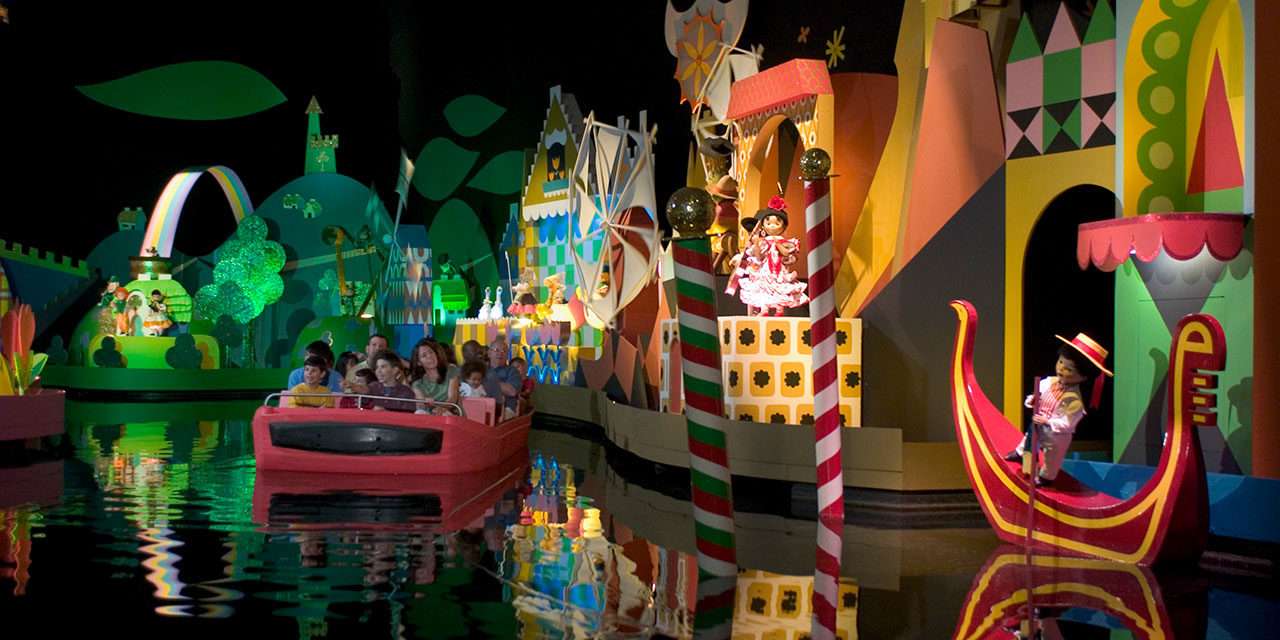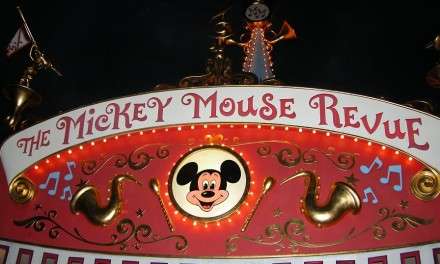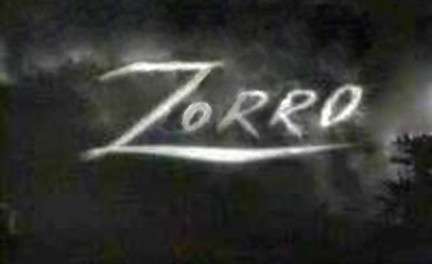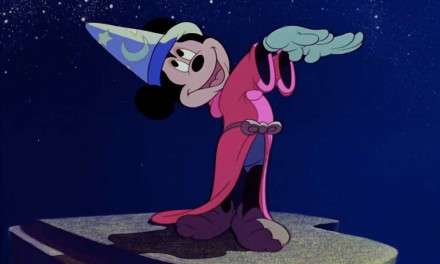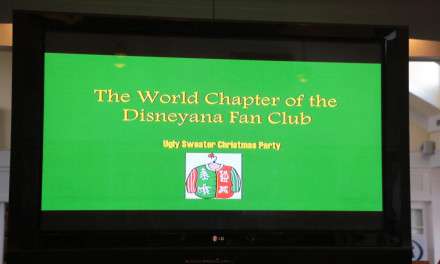Here is the quintessential attraction perhaps in all of Disney. “It’s a Small World” is another example of a classic, low tech offering that is made more special in the fact the Walt Disney himself nurtured into fruition. Even after its debut in the New York World’s Fair in 1964 55 years ago, it still delights, amuses and entertains thousands of guests, proving that you do not need high-tech to be enjoyable, but sound and meticulous planning by the one and only Walt Disney are what the doctor ordered…
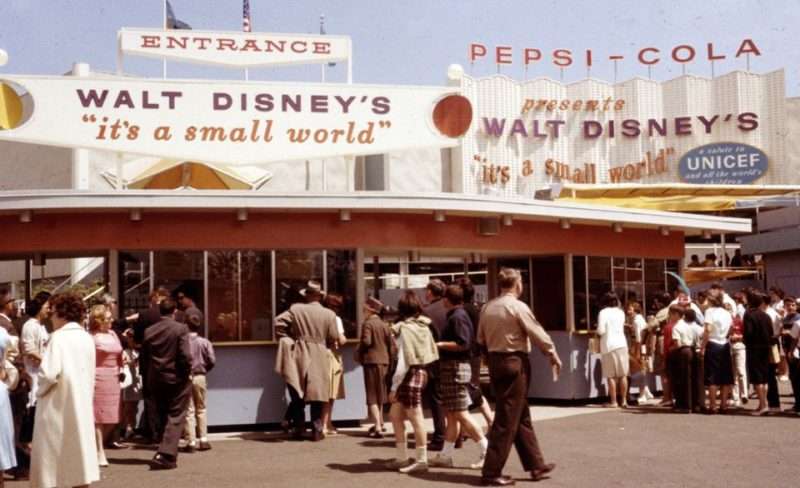
Everyone jokes about how after riding Disney’s “It’s a Small World” attraction, its iconic theme song stays in their head for days! And believe it or not, the reason is the song is played approximately 1,200 times a day! But the story behind this whimsical ride is classic Disney storytelling.
Walt Disney had always been active in many organizations during his lifetime. One such program was called “People to People” which was instituted by then President Eisenhower in 1956. This program was focused on eradicating misunderstandings, suspicions, and misperceptions of the counties around the world by having people from these different countries visit each other to eliminate the fear of the unknown and to understand the different cultures and beliefs each had. Walt had always wanted a similar attraction to help people around the world to better understand each other.
About a year before the New York World’s Fair began (From April 22nd, 1964 to October 17th, 1965) the Pepsi-Cola Company was collaborating with the United Nations for a pavilion at the fair dedicated to the children of the World’ welfare, a salute to UNICEF. Since 1946, this program provided humanitarian and developmental assistance to the world’s children. It is interesting to note that the motto of the World’s Fair was…” Peace through Understanding”. The problem was that Pepsi could not envision a concept for the pavilion. So literally at the eleventh hour, they contacted the Disney Company in hopes that Walt and his design team could come up with something “Magical”.
However, at the time, the studio was completely absorbed in its commitments to its pavilions slated for the fair, and the man in charge, Admiral Joe “Can Do” Fowler, who was the spearhead in the development and construction of Disneyland and later, Walt Disney World, declined. (The only time anyone remembers Joe saying “Can’t Do”), citing the previous commitments. When Walt found out, he blew his top and said…” I’ll make those decisions”. Tell Pepsi I’ll do it, and there were only 12 months before the opening of the fair. On February 15th, 1963 Walt did a Planning Design Feasibility Study for the pavilion. Imagineer Rolly Crump and the rest of the Imagineers believed Walt was being idealistic, mainly because of the time frame allotted to complete new pavilion and the fact that they were trying to get their audio-animatronic human figures to work correctly for the other pavilions. As usual, it was Walt himself who wanted a “little boat ride” to showcase the children of the world. He also came up with the name for the attraction…” The Children of the World” and the guests would ride on the “Fantasea”
Now with Walt’s approval, the gargantuan task of creating this new pavilion began. Imagineer Marc Davis envisioned the first idea for the attraction. Working with Bob Gurr and Arrow Manufacturing, the company who built the Matterhorn bobsleds, they developed the boat system for the ride. The chief art director was Davis and Claude Coats was assigned the layout. Walt wanted artist Mary Blair to help with artwork and design. Blair had left the studios earlier as an art supervisor and color stylist on many Disney classic films, i.e. Melody Time, Song of the South and Cinderella. Mary also earned distinction for her work on children’s books. Walt was also impressed with her “Los Posada” piece in the Three Caballeros film, showing Mexican children celebrating Christmas. Blair began work in June 1963.
Blair concentrated on the backgrounds and color schemes. Walt loved the first piece of the Siamese Dancing Girl and wanted the rest of the children done in that style. With a few preliminary ideas in hand, and approximately nine months until the opening of the fain, Joe Fowler presented the pavilion to the Pepsi executives in New York. They hated it. Supposedly one executive disdainfully said…” Why do we need this Mickey Mouse thing?” But famed actress Joan Crawford, a high ranking member of the board, stood up and declared…” We are going to do this” At a special press conference at the Waldorf Astoria Hotel on August 1963 Walt Disney, Herbert Barnett, president of Pepsi-Cola and Robert Moses, who was in charge of the World’s fair announced the pavilion and predicted that “Small World” would be one the most popular attractions.
The authentic costumes were designed by Mark Davis’ wife Alice. She began in earnest and letters were sent to the 26 countries represented in the ride for information on each countries dress. To ensure accuracy, she delved into the Disney library, museums and countless copies of National Geographic. Even the material used was authentic. The biggest challenge was durability. The costumes had to survive constant movement. The dolls were known as “Rubber Heads” and anything else was referred to as “Toys” Rolly Crump was assigned to design and build the toys. They were made from Styrofoam and Paper-Mache. The ice skating penguins were inspired by a toy on Yale Gracey’s desk, an ice skater spinning on a piece of glass by a magnet under it. The children were not made of rubber but a special vinyl and Dura-flex for resilience; because the mouths actually moved approximately a million times a month! The children were separated into three categories…Instrument players, singers, and dancers. They were also all the same size.
That famous or infamous song of the attraction was also Walt’s idea. The original idea was for each child to sing its national anthem, but the clashing of different languages was insufferable. Walt called in the “Boys”, the Sherman brothers to compose a “simple song” like Row, Row, Row Your Boat” that would be simple enough that it could be repeated over and over in different languages. Walt was overheard talking to the brothers and saying…” It’s a small world after all”, to describe the mood he was looking for. It was just a casual remark but ended up as the title of the song. The boys came up with the song but also had two more in the wings in case Walt didn’t like it. With little time to go, Walt, after hearing the first song said “That will work” which was a high compliment from him. In reality, Walt really loved the song.
With the deadline looming, a simple L-shaped building was designed and built in March in New York. Imagineer Claude Coates designed the layout of the river. Rolly Crump also designed the Tower of the Four Winds in front of the pavilion. Walt wanted a distinctive marquee to attract visitors. The complete attraction was built in California, taken down and trucked across the country to the fair, re-assembled and installed. The fair opened on April 22nd, 1964 and was the debut of “Pepsi Presents Walt Disney’s ‘It’s A Small World’ — a Salute to UNICEF and the World’s Children” It became the most popular pavilions at the fair. It was considered one of the top “Must See” pavilions. And this was despite the fact Pepsi charged a dollar admission for adults, $.50c for children, one of the few pavilions that charged admission. And even with all its accolades, Pepsi was still unhappy and considered the attraction an “embarrassment”. All because they thought it did not showcase their product very well and dropped its sponsorship when Walt moved it to Disneyland. Bank of America was happy to take over sponsorship.
Even today it’s considered a “Must-See” attraction. The attraction is found at five Disney parks worldwide. It opened in Disneyland, May 28th, 1966, Walt Disney World, October 1st, 1971, Tokyo Disneyland, April 15th, 1983, Disneyland Paris, April 12th, 1992 and Hong Kong Disneyland, April 28th, 2008.
Here are some interesting facts and figures about the attraction…
Each version of the attraction worldwide has at least 240 audio-animatronic figures. The entrances to Disneyland, Tokyo Disneyland, Disneyland Paris and Hong Kong Disneyland have a 30-foot-high clock tower, which exhibits the quarter hour with characters, props and music. Beginning on November 27th, 1997 the attraction transforms into a Christmas holiday theme with decorations, costumes, music, props and effects. The attraction showcases the children of the world celebrating the season. This transformation is now at Disneyland Paris, and Tokyo Disneyland. In Disneyland, there is a little blonde doll with glasses in a balloon over the Eiffel Tower scene, giving a nod to Mary Blair, designer of the dolls. In the Pinocchio Village Haus restaurant in Walt Disney World, there is a window seat where guests can wave to the guests as they begin the ride. Also, the outside façade is blended in with the facades of the other attractions, and not stand-alone. The Tokyo Disneyland attraction is the largest section of any version.
The song at Hong Kong Disneyland has four new languages in the score… Cantonese, Putonghua, Korean and Tagalog. The score also showcases these Chinese instruments… the Xiao, the Guzheng, the Pipa and the Erhu. Disneyland and Hong Kong Disneyland have dolls dressed up an Ariel and Flounder, Mulan and Mushu, Aladdin and Jasmine and Donald Duck, Panchito and Jose Carioca, the Three Caballeros. Other facts…It was created for the World’s Fair. They never expected it to last over 50 years. Money was no object for the costumes. Walt said… “Do whatever it takes to make these look like dolls every woman in the world would want to have”. After the attraction was moved back to Disneyland, shipping stickers with 1965 can still be seen on the back of some pieces.
Here are the lyrics of that Stick in your head song… It’s a world of laughter, a world of tears; it’s a world of hopes and a world of fears. There’s so much that we share, that it’s the time we’re aware it’s a small world after all. There is just one moon, and one golden sun And a smile mean, Friendship to everyone. Though the mountains divide, and the oceans are wide, it’s a small world after all. So, next time you take the “The Happiest Cruise That Ever Sailed” be prepared to hum that memorable Sherman Brothers song for the rest of the day!

